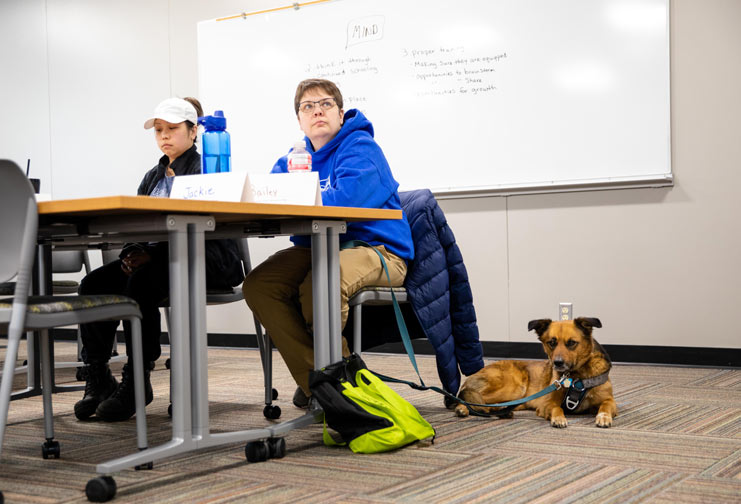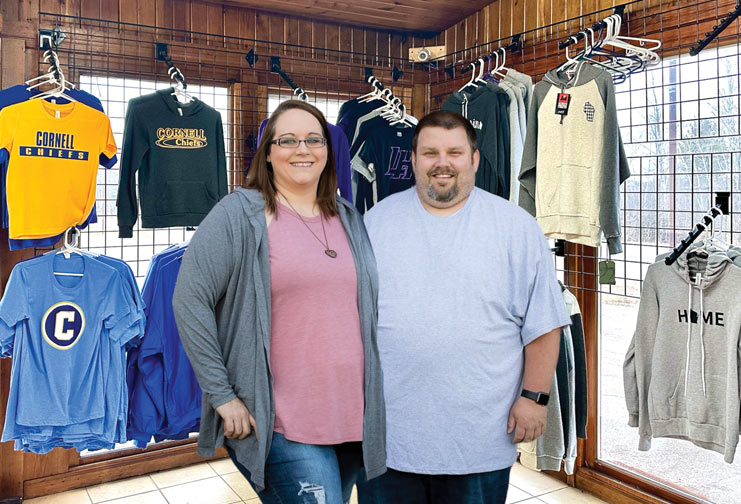Tuesday, June 20, 2023
Student’s service dog gets A+ at CVTC

Jackie Stygar, 46, of Altoona, trained Bailey, a German Shepherd and Border Collie mix rescue from Texas, to be her service dog. Stygar has an anxiety disorder that disrupts her daily life. With Bailey, she can go out in public and feels confident Bailey will do her job to navigate Stygar away from stressful situations and lay on her upper torso to ground her during an anxiety attack.
Jackie Stygar and Bailey don’t have the typical human/dog relationship.
Without Bailey, a German Shepherd and Border Collie mix, Stygar’s world would be small and closed in. The 46-year-old Altoona woman wouldn’t be able to grocery shop, go anywhere with crowds or go to any new places. Her debilitating anxiety would stop her in her tracks.
Adopting Bailey in 2019 opened a new world for Stygar. Having her service dog has allowed Stygar to feel comfortable working at the L.E. Phillips Career Development Center and taking an eight-week management course at Chippewa Valley Technical College.
Stygar said her manager at the Center knew she had a service dog and only asked for vaccine documentation. Her CVTC instructor, Connie LeCleir-Meyer, was welcoming to both Stygar and Bailey right away.
“Bailey has been an ideal student,” LeCleir-Meyer said. “Jackie (Stygar) has been great too, of course, but Bailey comes in, looks around and is like, ‘Yeah, I know these people.’ She’s not bothersome or the king of the hill. She’s allowing Stygar to come to class and learn.”
Before Stygar adopted and trained Bailey, Stygar would have foregone the class or had asked her sister to attend with her.
“I didn’t know I needed a service dog until it was brought up in a therapy session,” Stygar said. “Because of my anxiety disorder, I relied on having another person, like my sister, with me when I was going to be in an anxiety-raising situation.”
It took her about five years to find the perfect service dog for her. She researched how to choose and train a service dog. She knew she wanted to train her own dog because already-trained dogs can cost $10,000 or more.
After traveling to Elkhart Lake to inquire about Bailey (then Tashi), a rescue from Texas, it took about a month for Stygar and Bailey to get to know each other. Bailey was more of a pet than a service dog during that time, Stygar said.
At the three-month mark, Stygar started obedience classes twice a week where Bailey earned her Canine Citizenship and Therapy Dog certifications.
“We would also go on morning and afternoon walks where I would try to expose her to different things that she would be around on a daily basis with me, like walking next to a grocery cart, getting her used to ignoring people while she was working, and primarily focusing on her job and me,” Stygar said. “Every day she is still learning and training. A service dog's training never truly ends.”
Bailey knows she’s on duty when the service vest comes out and Stygar tells her, “We are going to work,” Stygar said.
“When she is wearing her service dog vest, she is focused and ready to work, and she is immediately focused on what I am doing,” Stygar said. “When Bailey isn’t working, she is a spunky, fun-loving dog that runs and plays with toys.”
LeCleir-Meyer said she is impressed by Stygar and her service dog.
“When someone has a service dog, people don’t understand what that means,” LeCleir-Meyer said. “The dog is working. If the dog is alerted, let the dog do its thing.”
But for LeCleir-Meyer, it was more about Stygar and making sure she was able to learn. LeCleir-Meyer knew Stygar really pushed herself by signing up for the class and going out in public to learn. It’s not that she can’t do it, but she does it in a different way from others, LeCleir-Meyer said.
To make the most of the class without triggering her anxiety, Stygar asked to look at materials ahead of time. LeCleir-Meyer said she could also tell that Stygar was reticent to raise her hand initially. She also does not readily volunteer if something is requested during class.
LeCleir-Meyer recalls when Bailey was alerted to Stygar’s anxiety while in class. Stygar and Bailey left the room and returned when the anxiety attack, which sometimes looks like a seizure, had passed.
Stygar said Bailey makes daily living easier. She felt welcome on campus and in class with Bailey at CVTC.
“Before I had Bailey, just going out in crowds and trying new things was extremely overwhelming for me,” she said. “Bailey helps keep me grounded. Without her, I would be much more introverted than I already am, but I’d also be less likely to try new things or meet new people.”
Service animals vs. emotional support animals
Jackie Stygar knows it’s not her job to educate the public, but she’ll take every opportunity to do so.
Bailey, Stygar’s service dog, is trained to hone in on Stygar’s anxiety levels.
Stygar said under the Americans with Disabilities Act (ADA), a service dog is not the same as an Emotional Support Animal (ESA).
According to the American Kennel Club (AKC), the main difference between emotional support animals (ESA) and service dogs is that ESAs may be trained for a specific owner, but they are not trained for specific tasks or duties to aid a person with a disability.
An ESA helps to provide comfort and companionship, whereas a service dog helps with specially trained tasks for the specific handler.
“A working service dog is not a pet,” Stygar said. “Please let them do their job. Also, do not touch, talk to, feed, or distract the dog while they are wearing their harness or vest. The dog needs to concentrate on their duty for the safety of their handler.”


